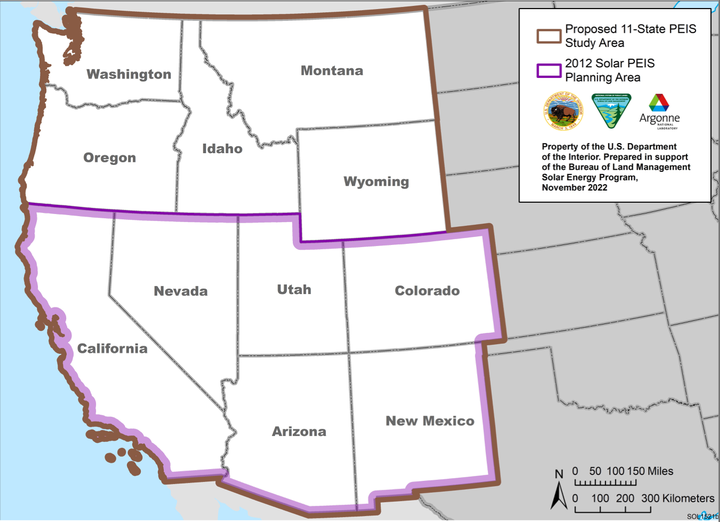How to plan the least risky places for solar development on public lands in the West
 Image via BLM ePlanning
Image via BLM ePlanningBureau of Land Management’s Western Solar Plan
The six most sunny states in the West already had a plan for where to put utility-scale solar PV on public lands administered by the BLM. When that plan was created, solar panel efficiency prevented their economic viability in less sunny places, like the Pacific Northwest. But now solar PV has higher efficiency which makes many more places in the West amenable to large solar installations. The BLM’s new Western solar plan would incorporate all eleven western states, instead of the original six, but it came with some roadbumps.
As hinted at in the authors section of the blog, Here Comes the Sun: Proactive solar thinking from the BLM, I spearheaded the Idaho Conservation League’s position on solar development on BLM land. However, it required careful internal conversations with our Public Lands, Wildlife, and Energy-focused colleagues. Trying to find the space in the venn diagram where we can all agree was no small feat because of our own unique perspectives. Trying to find the literal space on the map where we agreed energy projects can and should go is easier said than done. This robust effort inside the environmental non-profit world is beginning to seep into the public discourse through Klein and Thompson’s Abundance framework.
To briefly summarize, Klein & Thompson argue that government “needs to justify itself not though the rules it follows but through the outcomes it delivers.” They also critique the post-1970s development of “liberal legalism” because it has “convinced itself that the state’s legitimacy would be earned though compliance with an endless uncatalogued of rules and restraints rather than through getting things done for the people it claimed to serve.” While many will be sympathetic to these arguments, the policy atmospherics of the book need to be implemented on the ground. And that’s where you find reasonable, but uncomfortable, trade offs.
Brief note on the real and percieved land use impacts of solar
Idaho has ~53.5 million acres, 22% is BLM-administered land mostly in the southern portion of the state where you’ll find an abundance of sagebrush-step ecosystems. Of the 11.7 million acres of BLM-administered land in Idaho, only 0.7% of that (90,000 acres) are reasonably foreseeable to have solar on them in a 2050 fully decarbonized scenario. You can imagine how folks felt about public lands having solar on them when the Western Solar Plan was presented. Of course, there’s more outrage today (Summer 2025) now that 21.7 million acres of Forest Service and BLM administered lands in Idaho are up for sale.
A reality check on what is actually negatively impacting ecosystems in the Mountain West
For decades, the Mountain West has been pressured by invasive species like cheatgrass, Medusahead, and other annual species that are swallowing up the sagebrush sea. But this is an old problem. Cheatgrass in particular was likely introduced in the late 1800’s by ranchers wanting more feed for their cattle and the invasion front has continued onward ever since. While there are plenty of Sage-grouse in southern Idaho, new modelling from the United States Geological Service shows the only place sagebrush (and thus the sagebrush-obligate species Sage-grouse) will survive in Idaho is in the upper elevations of the Salmon-Challis National Forest. Think of living in a two story house where you have free roam, but within my lifetime the only place you can survive is on the 2nd story, and only on the queen-sized bed.
Their range contraction is sad, especially so because there are dozens more species that depend on sagebrush for their life cycles as well. Energy balance models used by the USGS are fauna and wildlife-agnostic because they’re physics forward. We can lament their range contraction, but we cannot pretend like we can maintain sagebrush and sage-grouse in the current places they are today for the next generation. There simply won’t be enough water, it will be too hot, there are too many invasive species pressures, and wildfires will eat them up faster than they can grow. This situation isn’t unique to Sage-grouse. There’s a two part series from Sammy Roth’s podcast about an endangered flower growing on boron-rich soils that are also at the edge of a lithium mine. Climate change is threatening the habitat range of Tiehm’s Buckwheat, and we need lithium for batteries so that we can stop burning fossil fuels and use renewable energy instead.
I say above and will reiterate, “there are no right answers, only trade-offs”. The intersection of energy and environmental issues are where it’s most obvious. I encourage you to read the ICL blog about BLM’s plans for solar development on public lands because it is a real life example of grappling with those issues. It doesn’t do so perfectly, with the second Trump administration most of these solar plans are on hold, but the careful analysis and practically constraints are well reasoned to the point that not only did I agree with the BLM, but I convinced my colleagues to support their preferred project pathways as well. That’s a winning plan, but it may take a few more years before being implemented.